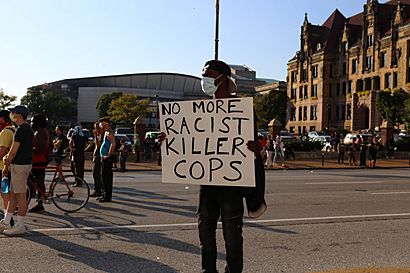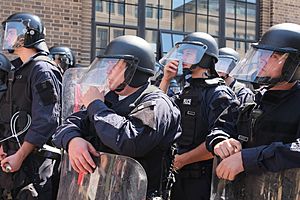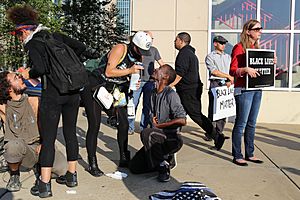2017 St. Louis protests facts for kids
Quick facts for kids 2017 St. Louis Protests |
|||
|---|---|---|---|
| Part of Shooting of Anthony Lamar Smith | |||

Protesters in September 2017 in downtown St. Louis
|
|||
| Date | September 15, 2017– November 24, 2017 | ||
| Location |
St. Louis, Missouri and nearby areas in St. Louis County, Missouri
|
||
| Caused by | Acquittal of officer Jason Stockley in the shooting of Anthony Lamar Smith | ||
| Methods | Protests, civil disobedience, vandalism | ||
| Parties to the civil conflict | |||
|
|||
| Number | |||
|
|||
| Casualties | |||
| Injuries | 14 | ||
| Arrested | 300+ | ||
Starting on September 15, 2017, many protests happened in St. Louis, Missouri. These protests began after a former St. Louis police officer, Jason Stockley, was found not guilty. He had been involved in the shooting of Anthony Lamar Smith, a Black man.
Over 160 people were arrested in the first three days. Most of these protests were peaceful. However, some people criticized how the police and government handled the demonstrations. This led to lawsuits from the ACLU.
What Happened in St. Louis?
Protests Begin: September 2017
First Day: September 15
Around 200 to 300 people gathered in downtown St. Louis near the courthouse. The protests were mostly calm. Police used pepper spray a few times. This happened when protesters reacted strongly to police in riot gear. It also happened after some people climbed on an empty police car and damaged it.
Later, the demonstrations moved to the Central West End, St. Louis neighborhood. The crowd grew to over 1,000 people. Things stayed peaceful until about 9:45 PM. This was when protesters reached the home of mayor Lyda Krewson. Even though protest leaders asked them not to, at least one person threw a rock through the mayor's window. The mayor was not believed to be home.
Most protesters left right away. But police used pepper spray and tear gas on those who remained. This pushed people through the Central West End's shopping area. There, some angry protesters damaged several businesses. In total, 33 people were arrested. Most of them were from the local area.
More Protests: September 16-17
On September 16, protesters marched through a shopping center in Des Peres, a St. Louis suburb. They also blocked a road. Later, a peaceful march went through University City, Missouri. As night came, some demonstrators threw objects at police. They also broke storefront windows as police moved them down Delmar Boulevard. Twenty-three businesses and a police car were damaged. Police arrested nine people.
On September 17, about 1,000 people protested outside police headquarters in downtown St. Louis. The event was peaceful until a small group started breaking windows at a Marriott hotel and other businesses. Police arrested 123 people. Police also said unknown substances were thrown at them. An officer was taken to the hospital with minor injuries. Among those arrested were an undercover police officer and a photojournalist.
Continued Demonstrations: Late September
On September 19, protesters gathered outside the downtown St. Louis jail. Two days later, on September 21, police in Richmond Heights closed the St. Louis Galleria mall. This happened after a group of protesters blocked a busy intersection nearby. Protests also started outside Busch Stadium in downtown St. Louis during a Billy Joel concert.
On September 23, protesters marched through the Saint Louis Galleria mall again. St. Louis County Police said they told the demonstrators to leave. Police made 22 arrests. One officer and two protesters were hurt. Some protesters said the police did not give a clear order to leave.
On September 29, a group of protesters went to a baseball game at Busch Stadium. They unfurled a banner that showed a cardinal, like the St. Louis baseball team's mascot. It said "#ExpectUs" and "Stop Killing Us," with a "Black Lives Matter" sign. Police removed these protesters from the stadium. At least two protesters were arrested outside the stadium as well.
On September 30, protesters briefly returned to the St. Louis Galleria. They chanted "Black lives matter" and "If we don't get it, shut it down!" as they marched. They also spoke to shoppers and onlookers.
Major Arrests and Road Closures: October 3
On October 3, 143 people were arrested. This happened after a group of protesters blocked and briefly closed a major highway, Interstate 64, at Kingshighway. This was the highest number of arrests in one night since the protests started.
On October 5, a group of protesters blocked traffic at Hampton Avenue and Chippewa Street. They then marched to the nearby St. Louis Police Officers Association. They called for its spokesman to be fired.
Protests Spread to Ferguson: October
On October 6, protests returned to Ferguson, a nearby city. This was three years after the shooting of Michael Brown there. The Ferguson protesters first stopped outside the Ferguson Market. This was where Michael Brown had an interaction before he was shot by an officer. They later moved to the Ferguson police headquarters. A video online showed Ferguson protesters with "Black Lives Matter" signs. They stood around a burning flag and chanted "we can't take it no more."
More Ferguson protests happened on October 13. Five out of 50 protesters were arrested. They refused to leave the street in front of the police headquarters. Police had warned them two or three times to move to the sidewalk. On October 14, 200 peaceful protesters marched through the streets of downtown St. Louis.
Final Protests: November
On October 21, protesters joined State Representative Bruce Franks Jr. at an AFL-CIO Convention in downtown St. Louis. The convention staff would not let the demonstrators in, even Rep. Franks, who was supposed to speak. However, some trade union members at the conference joined the protest. They demanded that all protesters be allowed inside.
On November 24, seven protesters, including Rep. Franks, were arrested. This happened after they tried to disrupt Black Friday sales at the St. Louis Galleria. About 50 protesters arrived, forcing the mall to close for less than an hour. The mall reopened after most protesters had left.
How People Reacted
Police and City Leaders Speak Out
Acting Police Commissioner Lawrence O'Toole spoke about the protests with Mayor Lyda Krewson. He said that many demonstrators were peaceful. But he added that after dark, some people started to damage property and hurt police officers. Mayor Krewson said she was saddened by the situation. She encouraged people in St. Louis to be kind to each other. She also asked them to understand that everyone has different experiences and feelings.
Missouri Governor Eric Greitens warned protesters that they could be arrested for property damage. He said that in the past, leaders let people break windows and start fires. But he stated, "Not this time." He said police arrested those who damaged property. He called them "criminals," not protesters.
Events Cancelled or Postponed
Because of the unrest, some concerts were cancelled in St. Louis. The Irish rock band U2 and singer Ed Sheeran both cancelled their shows. Many other local events were also cancelled or postponed. These included a walk to end Alzheimer's, a Shakespeare Festival play, a Cardinals baseball team charity run, and a stand-up comedy show. A concert by the St. Louis Symphony was also cancelled. Several other events, like a peace festival and a science exhibit opening, were postponed.
ACLU Takes Action
On September 22, 2017, the American Civil Liberties Union (ACLU) sued the city of St. Louis. The ACLU is a group that works to protect people's rights. They sued because of how the city and police treated the protesters.



